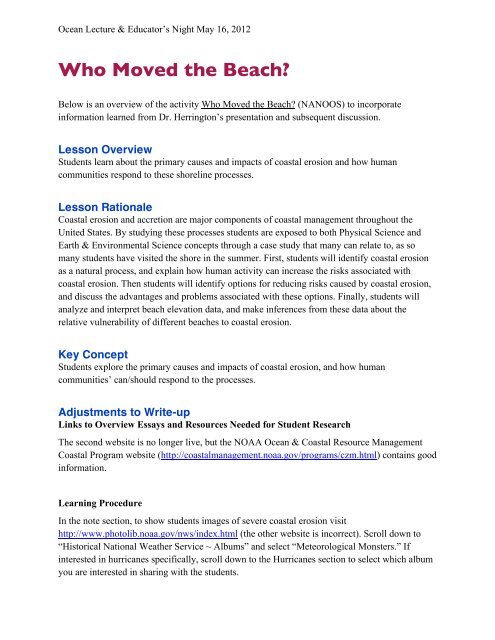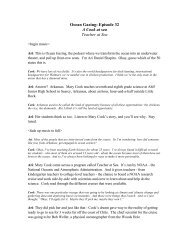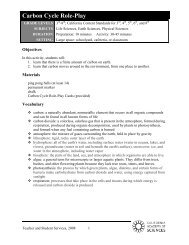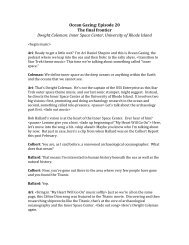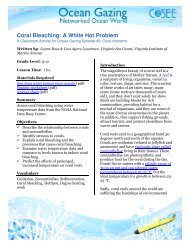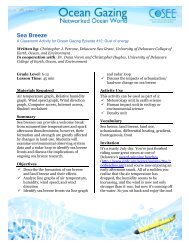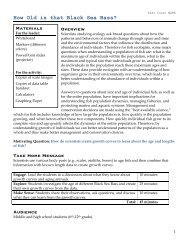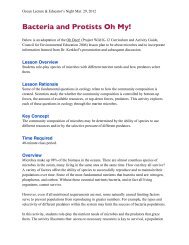Create successful ePaper yourself
Turn your PDF publications into a flip-book with our unique Google optimized e-Paper software.
Ocean Lecture & Educator’s Night May 16, 2012<strong>Who</strong> <strong>Moved</strong> <strong>the</strong> <strong>Beach</strong>?Below is an overview of <strong>the</strong> activity <strong>Who</strong> <strong>Moved</strong> <strong>the</strong> <strong>Beach</strong>? (NANOOS) to incorporateinformation learned from Dr. Herrington’s presentation and subsequent discussion.Lesson OverviewStudents learn about <strong>the</strong> primary causes and impacts of coastal erosion and how humancommunities respond to <strong>the</strong>se shoreline processes.Lesson RationaleCoastal erosion and accretion are major components of coastal management throughout <strong>the</strong>United States. By studying <strong>the</strong>se processes students are exposed to both Physical Science andEarth & Environmental Science concepts through a case study that many can relate to, as somany students have visited <strong>the</strong> shore in <strong>the</strong> summer. First, students will identify coastal erosionas a natural process, and explain how human activity can increase <strong>the</strong> risks associated withcoastal erosion. Then students will identify options for reducing risks caused by coastal erosion,and discuss <strong>the</strong> advantages and problems associated with <strong>the</strong>se options. Finally, students willanalyze and interpret beach elevation data, and make inferences from <strong>the</strong>se data about <strong>the</strong>relative vulnerability of different beaches to coastal erosion.Key ConceptStudents explore <strong>the</strong> primary causes and impacts of coastal erosion, and how humancommunities’ can/should respond to <strong>the</strong> processes.Adjustments to Write-upLinks to Overview Essays and Resources Needed for Student ResearchThe second website is no longer live, but <strong>the</strong> NOAA Ocean & Coastal Resource ManagementCoastal Program website (http://coastalmanagement.noaa.gov/programs/czm.html) contains goodinformation.Learning ProcedureIn <strong>the</strong> note section, to show students images of severe coastal erosion visithttp://www.photolib.noaa.gov/nws/index.html (<strong>the</strong> o<strong>the</strong>r website is incorrect). Scroll down to“Historical National Wea<strong>the</strong>r Service ~ Albums” and select “Meteorological Monsters.” Ifinterested in hurricanes specifically, scroll down to <strong>the</strong> Hurricanes section to select which albumyou are interested in sharing with <strong>the</strong> students.
Ocean Lecture & Educator’s Night May 16, 2012In step 3, we have provided <strong>the</strong> data file (“who_moved_<strong>the</strong>_beachdata.txt”) to use in <strong>the</strong> activity.In step 4 in <strong>the</strong> second paragraph, <strong>the</strong> example of renourishment is no longer an active link.Instead visit http://www.csc.noaa.gov/magazine/2002/04/beach.html for a case study of beachrenourishment from a town in Long Island.The Me ConnectionTo access <strong>the</strong> full report, <strong>the</strong> correct URL is <strong>now</strong>www.epa.gov/climatechange/effects/downloads/takings.pdf.ExtensionsTo access information about how to build and use a stream table, <strong>the</strong> correct URL is <strong>now</strong>www.mostreamteam.org/Documents/how_to/streamtable.pdf.ResourcesTo access <strong>the</strong> National Coastal LIDAR data visithttp://www.csc.noaa.gov/digitalcoast/data/coastallidar.I was unable to find an active link for <strong>the</strong> “<strong>Beach</strong> Nourishment: A Guide for Local GovernmentOfficials.”To access <strong>the</strong> summary of <strong>the</strong> “Evaluation of Erosion Hazards” report, visithttp://research.fit.edu/sealevelriselibrary/documents/doc_mgr/455/US_Erosion_Hazards_Summary_-_Heinz_Ctr._2000.pdf. To access <strong>the</strong> full report, visithttp://www.fema.gov/pdf/library/erosion.pdf.
Coastal ManagementShoreline Erosion | Lesson PlanCOASTAL MANAGEMENT LESSON PLAN<strong>Who</strong> <strong>Moved</strong> <strong>the</strong> <strong>Beach</strong>?NOS TopicCoastal ManagementThemeShoreline ErosionLinks to Overview Essays and Resources Needed for StudentResearchhttp://www.oceanservice.noaa.gov/topics/coasts/assessment/http://coastalmanagement.noaa.gov/pcd/coastal_hazards.htmlSubject AreaEarth ScienceGrade Level9-12Focus QuestionWhat are <strong>the</strong> primary causes and impacts of coastal erosion,and how should human communities respond to this process?Learning Objectives• Students will identify coastal erosion as a natural process,and explain how human activity can increase <strong>the</strong> risks associatedwith coastal erosion.• Students will identify options for reducing risks caused bycoastal erosion, and discuss <strong>the</strong> advantages and problemsassociated with <strong>the</strong>se options.• Students will analyze and interpret beach elevation data, andmake inferences from <strong>the</strong>se data about <strong>the</strong> relative vulnerablilityof different beaches to coastal erosion.Materials Needed• (optional) Computers with internet access; if students donot have access to <strong>the</strong> internet, download copies of materi-oceanservice.noaa.gov/education 1
Shoreline Erosion | Lesson PlanCoastal Managementals cited under “Learning Procedure” and provide copies of<strong>the</strong>se materials to each student or student group• Copies of “Coastal Erosion Subject Review Worksheet,”one copy for each student or student group• Graph paper or computers with spreadsheet and graphingsoftwareAudio/Visual Materials NeededNoneTeaching TimeOne 45-minute class period, plus time for student researchSeating ArrangementClassroom style or groups of 3-4 studentsMaximum Number of Students30Key WordsErosionAccretionLongshore transportDuneBerm<strong>Beach</strong> profileBackground InformationAlmost half of <strong>the</strong> people living in <strong>the</strong> United States live near<strong>the</strong> coast. As <strong>the</strong> coastal population continues to grow, morepeople and property will be exposed to hazards caused bysevere storms, floods, shoreline erosion and o<strong>the</strong>r natural hazards.Homes and businesses are often built in low-lying areasand barrier islands that are particularly vulnerable to stormdamage. The potentially disastrous consequences of this trendbecame obvious during <strong>the</strong> summer of 2004 when residentsof Florida were battered by four major hurricanes withinsix weeks, resulting in billions of dollars worth of damage.Much of <strong>the</strong> price is eventually borne by American taxpayersthrough federal government funds for disaster relief and reconstruction.2 oceanservice.noaa.gov/education
Coastal ManagementShoreline Erosion | Lesson PlanWhile erosion and land subsidence (land sinking below sealevel), are less spectacular than strong storms, <strong>the</strong>y are justas important in economic terms. Erosion alone is estimatedto cause billions of dollars of damage every year along U.S.coasts. Subsidence around New Orleans has necessitated largeexpenditures for pumping and dike maintenance. Subsidencein Texas, Florida, and California threatens high-value landuses and causes damages that cost millions to repair.Attempts to protect against coastal hazards can cause additionalproblems. Sea walls intended to protect against storm wavescan actually accelerate beach erosion and reduce <strong>the</strong> capacity ofbeaches to absorb storm energy. As a result, buildings adjacentto <strong>the</strong> beaches are exposed to <strong>the</strong> full force of wind and waves.Human activities such as diking and drainage of land aroundNew Orleans, ground water removal in Texas and Florida, andextraction of oil and gas in California have accelerated subsidencein <strong>the</strong>se areas (see, for example, http://ga.water.usgs.gov/edu/earthgwlandsubside.html).Experience has shown that prevention is <strong>the</strong> best approach todeal with <strong>the</strong>se problems. It costs much less to prevent constructionin areas unsuitable for development than to providefunds for emergency response, cleanup, and reconstruction.NOAA’s Office of Ocean and Coastal Resource Managementworks in partnership with state governments to minimize <strong>the</strong>impact of coastal hazards by• Identifying areas that are most likely to be severely affectedby <strong>the</strong>se hazards;• Developing warning systems and response plans to minimizehuman exposure to hazardous events;• Establishing appropriate building codes; and• Restoring <strong>the</strong> natural protective functions of beaches anddunes.From 1996 to 2000, <strong>the</strong> National Ocean Service, NASA, andU.S. Geological Survey partnered in an Airborne LIDARAssessment of Coastal Erosion (k<strong>now</strong>n as <strong>the</strong> ALACE project).LIDAR stands for light detecting and ranging, and is partof NASA’s Airborne Topographic Mapper (ATM). The ATMsystem uses a laser altimeter installed in an aircraft. As <strong>the</strong>aircraft flies along <strong>the</strong> coast, <strong>the</strong> altimeter scans <strong>the</strong> earth’soceanservice.noaa.gov/education 3
Shoreline Erosion | Lesson PlanCoastal Managementsurface in a path several hundred meters wide, and acquiresan estimate of ground elevation every few square meters. TheALACE project collected topographic data (elevations of dunesand beaches) along U.S. coasts. These data have been used tocreate maps that show <strong>the</strong> relative vulnerability to coastal erosion.These maps can be used to quickly locate areas that maybe severely impacted by coastal storms, to help plans for emergencyresponse as well as environmentally appropriate development.For more information on LIDAR mapping, visit http://www.csc.noaa.gov/products/nchaz/htm/ldarmenu.htm.In this lesson, students will learn about <strong>the</strong> major causes andimpacts of coastal erosion, and will use elevation data to constructprofiles of three beaches and make inferences about erosionprocesses on <strong>the</strong>se beaches.Learning ProcedureNote: If you want to introduce this lesson by showing imagesof severe coastal erosion, such as that caused by hurricanes,visit http://www.photolib.noaa.gov/historic/nws/.1.Tell students that <strong>the</strong>ir assignment is to learn about coastalerosion processes by completing <strong>the</strong> “Coastal Erosion SubjectReview Worksheet.” If students do not have access to <strong>the</strong> internet,download copies of materials cited at <strong>the</strong> beginning of <strong>the</strong>worksheet and make one copy of each article available to eachstudent or student group.2.Review answers for <strong>the</strong> worksheet. The correct answers are:(1) <strong>Beach</strong> sand originates mainly from rivers and streams, andalso comes from wea<strong>the</strong>ring of exposed rock formations, andfrom <strong>the</strong> deterioration of shells, corals, and skeletal fragments.(2) Coastal erosion is a natural process that removes sedimentfrom shorelines. Ano<strong>the</strong>r natural process that deposits sedimenton shorelines is k<strong>now</strong>n as accretion.(3) Sand is generally moved offshore by high-energy wavesduring winter months, and is returned by gentle waves duringsummer months.4 oceanservice.noaa.gov/education
Coastal ManagementShoreline Erosion | Lesson Plan(4) Movement of sand parallel to <strong>the</strong> coast by wave action,wind, and currents is k<strong>now</strong>n as longshore transport.(5) Sea walls, jetties, and bulkheads may contribute to erosionbecause <strong>the</strong>y affect natural water currents and prevent sandfrom shifting along coastlines to replenish beaches.(6) The first dune ridge or beach berm (if <strong>the</strong>re is no dunepresent) are <strong>the</strong> “first line of defense” against coastal erosionfrom wind and waves.(7) Barrier islands are composed primarily of sand and are <strong>the</strong>most dynamic land masses along <strong>the</strong> open-ocean coast.(8) The impact of a storm on a barrier island is dependent onstorm characteristics and <strong>the</strong> elevation of <strong>the</strong> barrier islandwhen <strong>the</strong> storm makes landfall.(9) The Coastal Change Hazard Scale categorizes net erosionduring storms into four impact levels or ”regimes.”(10) In <strong>the</strong> Collision Regime, waves cross <strong>the</strong> base of dunes,causing erosion and semi-permanent changes.(11) In <strong>the</strong> Inundation Regime, storm waves are high enoughto completely submerge <strong>the</strong> island, allowing sand to be transportedover a distance of one or more kilometers toward <strong>the</strong>mainland.(12) In <strong>the</strong> Overwash Regime, waves exceed <strong>the</strong> elevation of<strong>the</strong> dune or beach berm (if no dune is present), causing sandto be transported toward <strong>the</strong> mainland so <strong>the</strong> barrier island“migrates” landward.(13) In <strong>the</strong> Swash Regime, waves are confined to <strong>the</strong> beach.Sand may move offshore, but will be eventually returned so<strong>the</strong>re is no net erosion.(14) Over <strong>the</strong> next 60 years, erosion may claim one of everyfour houses within 500 feet of <strong>the</strong> U.S. shoreline. [Accordingto a study by th H. John Heinz III Center for Science,Economics and <strong>the</strong> Environment; see “Resources”]oceanservice.noaa.gov/education 5
Shoreline Erosion | Lesson PlanCoastal Management(15) Most of <strong>the</strong> damage from erosion over <strong>the</strong> next 60 yearswill occur in low-lying areas that also have <strong>the</strong> highest riskfrom flooding.(16) When <strong>the</strong> Cape Hatteras lighthouse was constructed in1870, it was 1,500 feet from <strong>the</strong> shore. By 1987, <strong>the</strong> lighthousewas 160 feet from <strong>the</strong> sea due to coastal erosion.(17) About 87,000 homes are located on low-lying land orbluffs that are likely to erode into <strong>the</strong> ocean or <strong>the</strong> Great Lakesover <strong>the</strong> next 60 years.(18) Without additional beach nourishment or structural protection,roughly 1,500 homes and <strong>the</strong> land on which <strong>the</strong>y arebuilt will be lost to erosion each year. [According to a studyby th H. John Heinz III Center for Science, Economics and <strong>the</strong>Environment; see “Resources”](19) The average annual erosion rate along <strong>the</strong> Atlantic coast isabout 2 to 3 feet.(20) The highest erosion rates in <strong>the</strong> United States are in coastalareas bordering <strong>the</strong> Gulf of Mexico.(21) A major storm can erode <strong>the</strong> coast inland 100 feet or morein a single day.(22) The Atlantic coast has <strong>the</strong> largest number of structureslocated within <strong>the</strong> 60-year erosion hazard area.(23) Ecological concerns related to erosion arise primarilybecause of <strong>the</strong> scarcity of wetlands.(24) Coastal erosion may increase during <strong>the</strong> next 50 to 100years if polar ice caps melt and cause a rise in sea levels.(25) People have three choices when erosion poses a threat:leave, renourish, or build.3.Review <strong>the</strong> idea of <strong>the</strong> ALACE project and LIDAR mapping(which students may have encountered while researching6 oceanservice.noaa.gov/education
Coastal ManagementShoreline Erosion | Lesson Plananswers for <strong>the</strong> worksheet). Ask students what sorts of beachprofiles might be most resistant to wave erosion. Provideeach student or student group with copies of <strong>the</strong> text file“threebeaches.txt” and instruct each group to plot each of <strong>the</strong>four sets of data on a single graph. If possible, have studentsimport <strong>the</strong> data into a spreadsheet program (such as MicrosoftExcel) and use this program to construct <strong>the</strong>ir graph. Detaileddirections for this process can be found at http://www.vims.edu/bridge/beachgraph.html. There are three changes needed to <strong>the</strong>seinstructions:(a) use <strong>the</strong> “threebeaches.txt” file instead of “beachdata.txt”;(b) be sure that <strong>the</strong> format specified in “File Origin” (step1) matches <strong>the</strong> operating system that your students areusing; and(c) be sure students adjust <strong>the</strong> size of <strong>the</strong> first row so that <strong>the</strong>entire label can be read.4.Lead a discussion of students’ beach profiles. Ask studentsto infer which of <strong>the</strong> three beaches might be most vulnerableto wave erosion. Paradise <strong>Beach</strong> and Shell <strong>Beach</strong> both haveconspicuous dunes, while Donkey <strong>Beach</strong> has a lower elevationand would be more susceptible to erosion by waves. Askwhat might account for <strong>the</strong> differences in <strong>the</strong> two profilesfor Paradise <strong>Beach</strong>. Students should recognize that in March<strong>the</strong> beach may have been recently exposed to winter stormsthat increase erosion and move sand offshore, but that bySeptember this sand could have been returned by <strong>the</strong> gentlerwaves typical of summer months. Be sure students realizethat <strong>the</strong> offshore areas that receive eroded sand are obviouslyinvolved in <strong>the</strong>se processes, and in fact are part of <strong>the</strong> totalbeach profile.Discuss <strong>the</strong> three options for responding to erosion threatslisted in <strong>the</strong> last question on <strong>the</strong> worksheet. Students shouldrealize that while leaving may be <strong>the</strong> least expensive option,this is often impractical where development has already takenplace. Renourishment, however, is seldom a permanent solution(see http://www3.csc.noaa.gov/beachnourishment/html/human/case.htm for an example). Similarly, various constructionoptions can make property more resistant to erosion, but structuressuch as sea walls, jetties, and bulkheads often increaseoceanservice.noaa.gov/education 7
Shoreline Erosion | Lesson PlanCoastal Managementerosion and shift <strong>the</strong> problem to o<strong>the</strong>r areas by interrupting<strong>the</strong> natural flow of sand.The Bridge Connectionhttp://www.vims.edu/bridge/archive0500.html – “Coastal Erosion:Where’s <strong>the</strong> <strong>Beach</strong>?”http://www.vims.edu/bridge/ – In <strong>the</strong> “Site Navigation” menuon <strong>the</strong> left, click on “Ocean Science Topics,” <strong>the</strong>n “MarineGeology” for links to resources on coastal erosion.The Me ConnectionMany people who live in erosion-prone areas believe that <strong>the</strong>yhave <strong>the</strong> right to take whatever steps are necessary to protect<strong>the</strong>ir property from erosion. For example, a 1998 report in <strong>the</strong>Maryland Law Review points out that more and more housesare being built just inland of sandy beaches that are generallyconsidered to be public lands. Because sea level is rising andmost shores are eroding, <strong>the</strong> ocean will eventually reach <strong>the</strong>sehouses unless <strong>the</strong> houses are moved or <strong>the</strong> sea is held back.The most common “solution” is to build a wall between <strong>the</strong>private dry land and <strong>the</strong> public beach. The result is that <strong>the</strong>private land is saved and <strong>the</strong> beach erodes away. In Marylandalone, more than three hundred miles of tidal shoreline havebeen “armored” in <strong>the</strong> last 20 years. For links to <strong>the</strong> full report,visit http://yosemite.epa.gov/oar/globalwarming.nsf/content/ResourceCenterPublicationsSLRTakings.html (this report is a 2.2mb, 121page pdf file).Have students write an essay explaining why <strong>the</strong>y support orreject this approach, and what arguments might be offered bysomeone with a view that opposes <strong>the</strong>ir own.ExtensionsVisit http://www.mostreamteam.org/pdfs/bldusng.pdf for informationon building and using a stream table to simulate erosionand o<strong>the</strong>r processes involving sediment transport by water(presented by <strong>the</strong> Missouri Stream Team Infocenter).Resourceshttp://www.csc.noaa.gov/crs/rs_apps/sensors/lidar.htm – NationalCoastal LIDAR data from NOAA’s Coastal Services Center8 oceanservice.noaa.gov/education
Coastal ManagementShoreline Erosion | Lesson Planhttp://ww3.csc.noaa.gov/beachnourishment/ – <strong>Beach</strong> Nourishment:A Guide for Local Government Officials from <strong>the</strong> NOAACoastal Services Centerhttp://www.heinzctr.org/NEW_WEB/PDF/erosnsum.pdf and http://www.heinzctr.org/NEW_WEB/PDF/erosnrpt.pdf – summary(23 pages, 544 kb) and full (252 pages, 3.9 mb) report,“Evaluation of Erosion Hazards” prepared by <strong>the</strong> H.John Heinz III Center for Science, Economics and <strong>the</strong>Environmenthttp://coastal.er.usgs.gov/hurricanes/ – U.S. Geological Survey“Hurricane and Extreme Storm Impact Studies” webpagehttp://archives.cnn.com/2000/fyi/news/09/20/coastal.erosion/index.html– CNNfyi article, “<strong>Beach</strong>es on <strong>the</strong> brink”National Science Education StandardsContent Standard A: Science as Inquiry• Abilities necessary to do scientific inquiry• Understandings about scientific inquiryContent Standard B: Physical Science• Motions and forces• Interactions of energy and matterContent Standard D: Earth and Space Science• Energy in <strong>the</strong> earth system• Geochemical cyclesContent Standard E: Science and Technology• Abilities of technological designContent Standard F: Science in Personal and SocialPerspectives• Natural resources• Environmental quality• Natural and human-induced hazards• Science and technology in local, national, and global challengesLinks to AAAS “Oceans Map” (aka benchmarks)5D/H3 – Human beings are part of <strong>the</strong> earth’s ecosystems.Human activities can, deliberately or inadvertently, alter <strong>the</strong>equilibrium in ecosystems.oceanservice.noaa.gov/education 9
Coastal ManagementShoreline Erosion | ReviewCOASTAL MANAGEMENT REVIEW SHEETCoastal Erosion Subject ReviewThe following reports and articles contain <strong>the</strong> informationneeded to complete this worksheet:“Evaluation of Erosion Hazards” prepared by <strong>the</strong> H. JohnHeinz III Center for Science, Economics and <strong>the</strong>Environment (summary report) http://www.heinzctr.org/NEW_WEB/PDF/erosnsum.pdf“Mapping Coastal Change Hazards” U.S.G.S. website beginningat http://coastal.er.usgs.gov/hurricanes/mappingchange/“Coastal Erosion: Where’s <strong>the</strong> <strong>Beach</strong>?” Bridge Data Tip at http://www.vims.edu/bridge/archive0500.html“<strong>Beach</strong>es on <strong>the</strong> Brink” CNNfyi.com article at http://archives.cnn.com/2000/fyi/news/09/20/coastal.erosion/index.html1. <strong>Beach</strong> sand originates mainly from __________, and alsocomes from __________, and from __________.2. Coastal erosion is a natural process that removes sedimentfrom shorelines. Ano<strong>the</strong>r natural process that deposits sedimenton shorelines is k<strong>now</strong>n as __________.3. Sand is generally moved offshore by high-energy wavesduring __________ months, and is returned by gentle wavesduring __________ months.4. Movement of sand parallel to <strong>the</strong> coast by wave action,wind, and currents is k<strong>now</strong>n as __________.5. Sea walls, jetties, and bulkheads may contribute to erosionbecause ________________________________________.6. The __________ or __________ (if <strong>the</strong>re is no dune present)are <strong>the</strong> “first line of defense” against coastal erosion fromwind and waves.oceanservice.noaa.gov/education 10
Coastal ManagementShoreline Erosion | Review7. __________ are composed primarily of sand and are <strong>the</strong> mostdynamic land masses along <strong>the</strong> open-ocean coast.8. The impact of a storm on a barrier island is dependenton storm characteristics and <strong>the</strong> __________ of <strong>the</strong> barrierisland when <strong>the</strong> storm makes landfall.9. The Coastal Change Hazard Scale categorizes net erosionduring storms into __________ impact levels or ”regimes.”10. In <strong>the</strong> __________ Regime, waves cross <strong>the</strong> base of dunes,causing erosion and semi-permanent changes.11. In <strong>the</strong> __________ Regime, storm waves are high enoughto completely submerge <strong>the</strong> island, allowing sand tobe transported over a distance of one or more kilometerstoward <strong>the</strong> mainland.12. In <strong>the</strong> __________ Regime, waves exceed <strong>the</strong> elevation of<strong>the</strong> dune or beach berm (if no dune is present), causingsand to be transported toward <strong>the</strong> mainland so <strong>the</strong> barrierisland “migrates” landward.13. In <strong>the</strong> __________ Regime, waves are confined to <strong>the</strong>beach. Sand may move offshore, but will be eventuallyreturned so <strong>the</strong>re is no net erosion.14. Over <strong>the</strong> next 60 years, erosion may claim __________ ofevery _________ houses within 500 feet of <strong>the</strong> U.S. shoreline.15. Most of <strong>the</strong> damage from erosion over <strong>the</strong> next 60 yearswill occur in low-lying areas that also have <strong>the</strong> highest riskfrom __________.16. When <strong>the</strong> Cape Hatteras lighthouse was constructed in1870, it was __________ feet from <strong>the</strong> shore. By 1987, <strong>the</strong>lighthouse was __________ feet from <strong>the</strong> sea due to coastalerosion.17. About 87,000 homes are located on low-lying land orbluffs that are likely to erode into <strong>the</strong> ocean or <strong>the</strong> GreatLakes over <strong>the</strong> next 60 years.oceanservice.noaa.gov/education 11
Shoreline Erosion | ReviewCoastal Management18. Without additional beach nourishment or structural protection,roughly __________ homes and <strong>the</strong> land on which <strong>the</strong>yare built will be lost to erosion each year.19. The average annual erosion rate along <strong>the</strong> Atlantic coast isabout__________ feet.20. The highest erosion rates in <strong>the</strong> United States are in coastalareas bordering ____________________.21. A major storm can erode <strong>the</strong> coast inland __________ feet ormore in a single day.22. The __________ coast has <strong>the</strong> largest number of structureslocated within <strong>the</strong> 60-year erosion hazard area.23. Ecological concerns related to erosion arise primarilybecause of <strong>the</strong> scarcity of __________.24. Coastal erosion may increase during <strong>the</strong> next 50 to 100years if polar ice caps melt and cause a rise in __________.25. People have three choices when erosion poses a threat:__________, __________, or __________.12 oceanservice.noaa.gov/education


